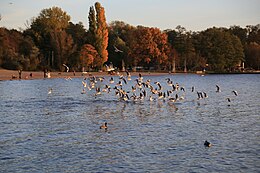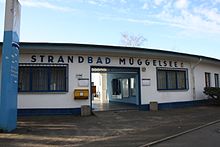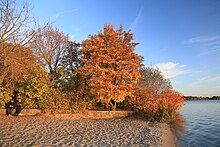Müggelsee lido
The Müggelsee lido , also known as the Rahnsdorf lido , is an open-air swimming pool in Berlin-Rahnsdorf on the north bank of the Müggelsee .
The lido , which is a listed building as a whole, was built at the beginning of the 20th century and continuously rebuilt and expanded until the 1980s . It stretches over a shore length of around 750 m with a total land area of 211,000 m² and offers a capacity for 25,000 bathers, including the nudist area.
Admission to the Müggelsee lido is free; Maintenance and operation are guaranteed by donations and public subsidies by the State of Berlin.
The bath has good transport connections with two tram stops on line 61 and parking spaces on Fürstenwalder Damm.
history
Early years

As early as 1910, on a private initiative, the first temporary buildings were erected on the site, which had previously been used by residents as a bathing area. The first fixed, partly wooden changing and toilet buildings as well as an entrance building were built in 1912 after the establishment of the "Freibad Müggelsee GmbH". In that opening year there were already more than 177,000 visitors.
1928-2006

After economic difficulties and a major fire in 1928, the facility was rebuilt in 1929/30 according to a design by Martin Wagner , who was also involved in the construction of the Wannsee lido , and Friedrich Hennings . The bathroom was significantly larger and built using reinforced concrete . In addition to a 160 m long terrace with a flight of stairs to the beach, the complex offered a variety of rooms for changing rooms, sanitary facilities, administration and supervision as well as various shops with services.
On the occasion of the “ World Youth Festival ” in 1951 and in 1976-78, the bath was renovated and expanded considerably to a total area of 121,000 m². Since then it has had a daily capacity of 25,000 guests. In addition to an open-air stage that was later removed , a new catering building, sauna and bowling facilities were built.
Until 2006, the Müggelsee lido remained in the administration of the Berlin bathing companies , which wanted to close it for financial reasons.
Current status
After the takeover by the Treptow-Köpenick district in 2006 and the consequent prevention of closure, clearing and security measures were initially carried out. The area is accessible to the public free of charge, although there is no official bathing operation. Gastronomy buildings and lido buildings are empty, while only the sauna building is still partially managed. The building fabric is permanently damaged, for example through cracks and leaks.
Since 2009 the bath has been kept in provisional operation through the initiative of the association “Bürger für Rahnsdorf eV”, which is committed to its preservation, and an unemployment benefit agency. However, visitors are little influenced by the condition of the facility. According to investors, around 110,000 people visited the lido in 2009 (300 visitors every day of the year). Other sources, including water sports enthusiasts from a canoeing club based on the lake, mention "significantly fewer than 40,000 visitors" per bathing season.
future
After a public expression of interest in the district to find an investor initially failed in 2008, three concepts for maintenance and operation were presented in 2010. In March 2011, the “Kühne Pool & Wellness” company from Schöneiche was selected by the district office as a future investor. For an estimated 6.12 million euros, a listed old building was to be renovated and a new entrance building erected. Furthermore, the construction of a year-round " wellness and spa " area, expanded saunas, fitness rooms, physiotherapy and a day care center with a total of around 50 work and apprenticeship positions was planned. Entry to the pool should remain free, and the district should not incur any costs. Completion was announced by the investor in 2014.
The area should be left to the investor for 99 years by means of a leasehold contract . However, since the property first had to be transferred to the district for this project and this turned out to be problematic, this solution quickly became questionable.
After further setbacks such as the district's declaration that a new Europe-wide tender was necessary, as well as the non-approval of some events on the lido area, Sven Kühne announced in a letter dated January 3, 2012 that he was no longer available as a possible investor to stand. The reservation of claims for damages against the district office is expressly mentioned.
Investments
terrain

The area covers a total area of 121,000 m² and offers space for 25,000 guests a day. In addition to an extensive beach area, there are meadow areas. There is a nudist area at the western end .
Adjacent to the lido there is a youth village in the west, which is operated by the youth association djo -Deutscher Regenbogen Landesverband Berlin eV . Here hostel places are offered for children and youth tourism, seminars and family trips. To the east there are jetties with slipways and a neighboring surf school with a bar and snack bar, which is open both in summer and when the lake is frozen in winter.
building
The lido buildings from 1929/30, designed by Martin Wagner and Friedrich Hennings and later rebuilt several times, are listed as an entire complex. This includes the terrace building, the entrance hall, the porter's apartment and the sculpture Maja , a bronze figure by Fritz Klimsch , which was created around 1931 and is now in the Heimatmuseum Berlin-Köpenick.
Beach
The lido offers an approximately 250 m long, freely accessible natural sandy beach area in the eastern area and an approximately 150 m long nudist beach in the western area , which is explicitly designated for nude bathing . Behind and between these two beach sections there are lightly wooded lawns. The concrete edge, which was built in GDR times and is now ailing, was removed at the beginning of the 2015 season. Since then, beach access has been possible again without restrictions. The 500,000 euro demolition was financed by compensatory measures during the construction of the south-east road link.
In the water, the bank is followed by a shallow water area leading approx. 60 m into the lake, which makes the outdoor pool particularly popular with families with children.
environment
The land areas of the Müggelsee lido are within Zone II (narrower protection zone) of the water protection area for the Friedrichshagen waterworks and the water areas are part of the LSG-54 Müggelsee and Fredersdorfer Mühlenfließ landscape protection area .
literature
- Development concept of the “Stiftung Strandbad Müggelsee iG” (PDF; 3.9 MB) March 2011. Accessed on September 8, 2011.
Web links
- Official information page on the lido of the city of Berlin (with information on the current water quality). Retrieved July 18, 2011.
- Development concept of the “Stiftung Strandbad Müggelsee iG” (PDF; 3.9 MB) Brochure with information and photos on the environment, history, usage concept, etc., March 2011. Accessed on July 18, 2011.
- Information page of the investor with history, current status and concept for future use. Retrieved July 18, 2011.
- Citizen for Rahnsdorf . Retrieved July 18, 2011.
Individual evidence
- ↑ a b Entry in the Berlin state monument list: Müggelsee lido
- ↑ Route route for tram 61. (PDF; 69 KB) Accessed on May 10, 2020 (stops “Licht- und Luftbad Müggelsee” and “Strandbad Müggelsee”).
- ↑ Development concept of the “Stiftung Strandbad Müggelsee iG” (PDF; 3.9 MB) March 2011. Accessed on September 8, 2011.
- ↑ a b c Märkische Oderzeitung: Riviera des Ostens: Müggelsee bathing area is to be renovated in accordance with historical monuments . May 18, 2010. Retrieved September 8, 2011.
- ↑ a b c Tagesspiegel: Investor found for lido at Müggelsee . March 18, 2011. Retrieved September 8, 2011.
- ↑ Kühne Pool & Wellness: Current state of the Müggelsee lido . Retrieved September 8, 2011.
- ↑ Strandbad Müggelsee (PDF; 1.8 MB) Accessed on January 12, 2012.
- ↑ Berlin Environmental Atlas: November 2nd, water protection areas (2009 edition). Retrieved May 10, 2020 .
- ^ NSG and LSG Müggelsee and Fredersdorfer Mühlenfließ. Retrieved May 10, 2020 .
Coordinates: 52 ° 26 ′ 43.4 " N , 13 ° 40 ′ 34.2" E



